BA Business: Business Decision Making Essay on A&B Plc
VerifiedAdded on 2023/01/09
|8
|1371
|59
Essay
AI Summary
This essay examines the investment decision-making processes of A&B Plc, a restaurant chain, focusing on its expansion strategies. The essay explores two investment options, a Dishwashing project and a Software Project, analyzing them using the Payback Period and Net Present Value (NPV) methods. The Payback Period method determines the time required to recover the initial investment, while NPV considers the time value of money to assess project profitability. The analysis reveals that Project B has a shorter payback period, but Project A generates a higher NPV. Furthermore, the essay discusses financial factors like profitability, interest rates, and depreciation, as well as non-financial factors such as employee training and organizational culture, which influence investment decisions. The conclusion emphasizes the importance of profitability and the use of financial techniques and non-financial aspects in making sound investment choices.

Essay
Paraphrase This Document
Need a fresh take? Get an instant paraphrase of this document with our AI Paraphraser

Table of Contents
INTRODUCTION.................................................................................................................................3
Task.......................................................................................................................................................3
Investment decision making..............................................................................................................3
CONCLUSION.....................................................................................................................................7
REFERENCES......................................................................................................................................8
INTRODUCTION.................................................................................................................................3
Task.......................................................................................................................................................3
Investment decision making..............................................................................................................3
CONCLUSION.....................................................................................................................................7
REFERENCES......................................................................................................................................8
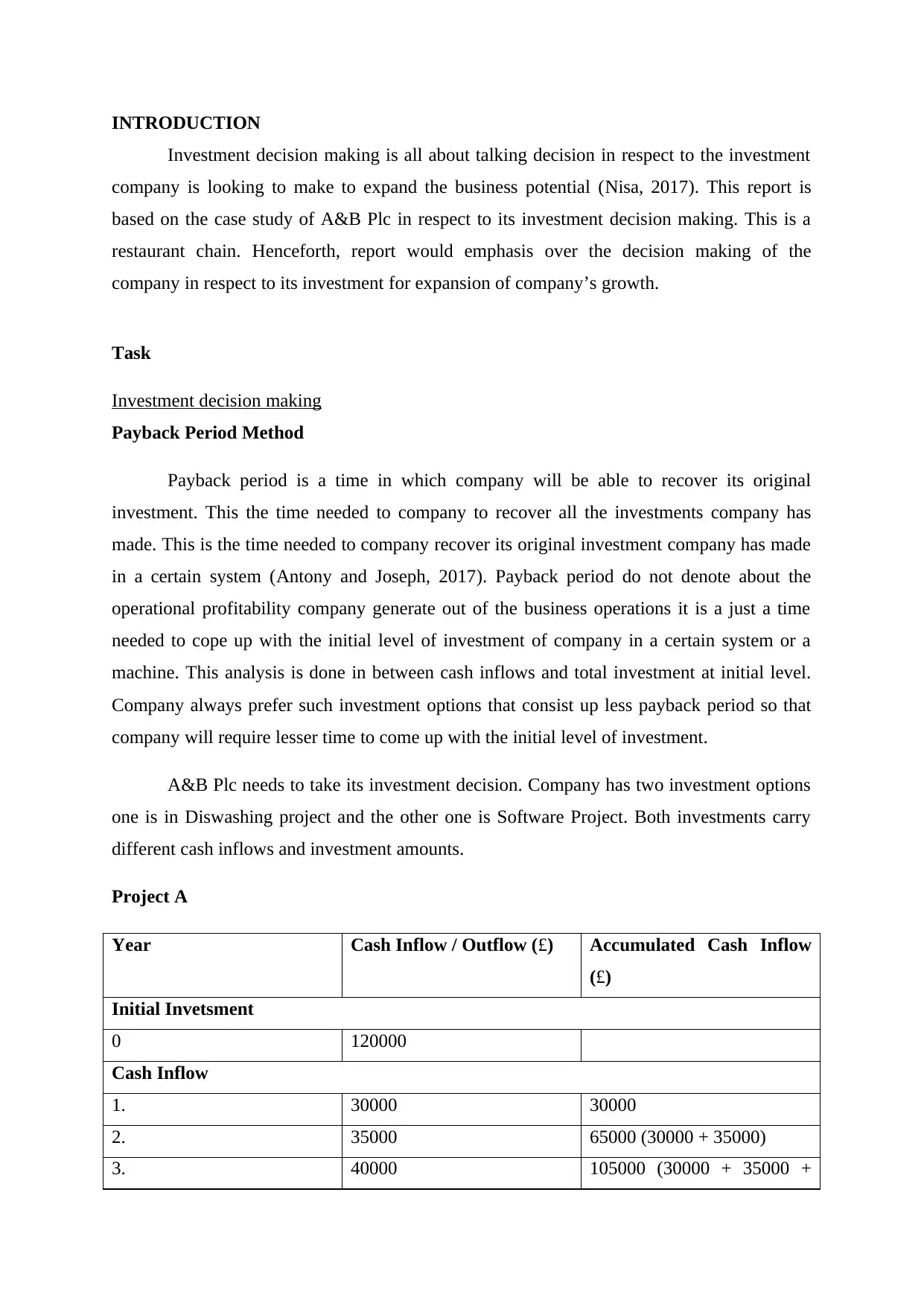
INTRODUCTION
Investment decision making is all about talking decision in respect to the investment
company is looking to make to expand the business potential (Nisa, 2017). This report is
based on the case study of A&B Plc in respect to its investment decision making. This is a
restaurant chain. Henceforth, report would emphasis over the decision making of the
company in respect to its investment for expansion of company’s growth.
Task
Investment decision making
Payback Period Method
Payback period is a time in which company will be able to recover its original
investment. This the time needed to company to recover all the investments company has
made. This is the time needed to company recover its original investment company has made
in a certain system (Antony and Joseph, 2017). Payback period do not denote about the
operational profitability company generate out of the business operations it is a just a time
needed to cope up with the initial level of investment of company in a certain system or a
machine. This analysis is done in between cash inflows and total investment at initial level.
Company always prefer such investment options that consist up less payback period so that
company will require lesser time to come up with the initial level of investment.
A&B Plc needs to take its investment decision. Company has two investment options
one is in Diswashing project and the other one is Software Project. Both investments carry
different cash inflows and investment amounts.
Project A
Year Cash Inflow / Outflow (£) Accumulated Cash Inflow
(£)
Initial Invetsment
0 120000
Cash Inflow
1. 30000 30000
2. 35000 65000 (30000 + 35000)
3. 40000 105000 (30000 + 35000 +
Investment decision making is all about talking decision in respect to the investment
company is looking to make to expand the business potential (Nisa, 2017). This report is
based on the case study of A&B Plc in respect to its investment decision making. This is a
restaurant chain. Henceforth, report would emphasis over the decision making of the
company in respect to its investment for expansion of company’s growth.
Task
Investment decision making
Payback Period Method
Payback period is a time in which company will be able to recover its original
investment. This the time needed to company to recover all the investments company has
made. This is the time needed to company recover its original investment company has made
in a certain system (Antony and Joseph, 2017). Payback period do not denote about the
operational profitability company generate out of the business operations it is a just a time
needed to cope up with the initial level of investment of company in a certain system or a
machine. This analysis is done in between cash inflows and total investment at initial level.
Company always prefer such investment options that consist up less payback period so that
company will require lesser time to come up with the initial level of investment.
A&B Plc needs to take its investment decision. Company has two investment options
one is in Diswashing project and the other one is Software Project. Both investments carry
different cash inflows and investment amounts.
Project A
Year Cash Inflow / Outflow (£) Accumulated Cash Inflow
(£)
Initial Invetsment
0 120000
Cash Inflow
1. 30000 30000
2. 35000 65000 (30000 + 35000)
3. 40000 105000 (30000 + 35000 +
⊘ This is a preview!⊘
Do you want full access?
Subscribe today to unlock all pages.

Trusted by 1+ million students worldwide
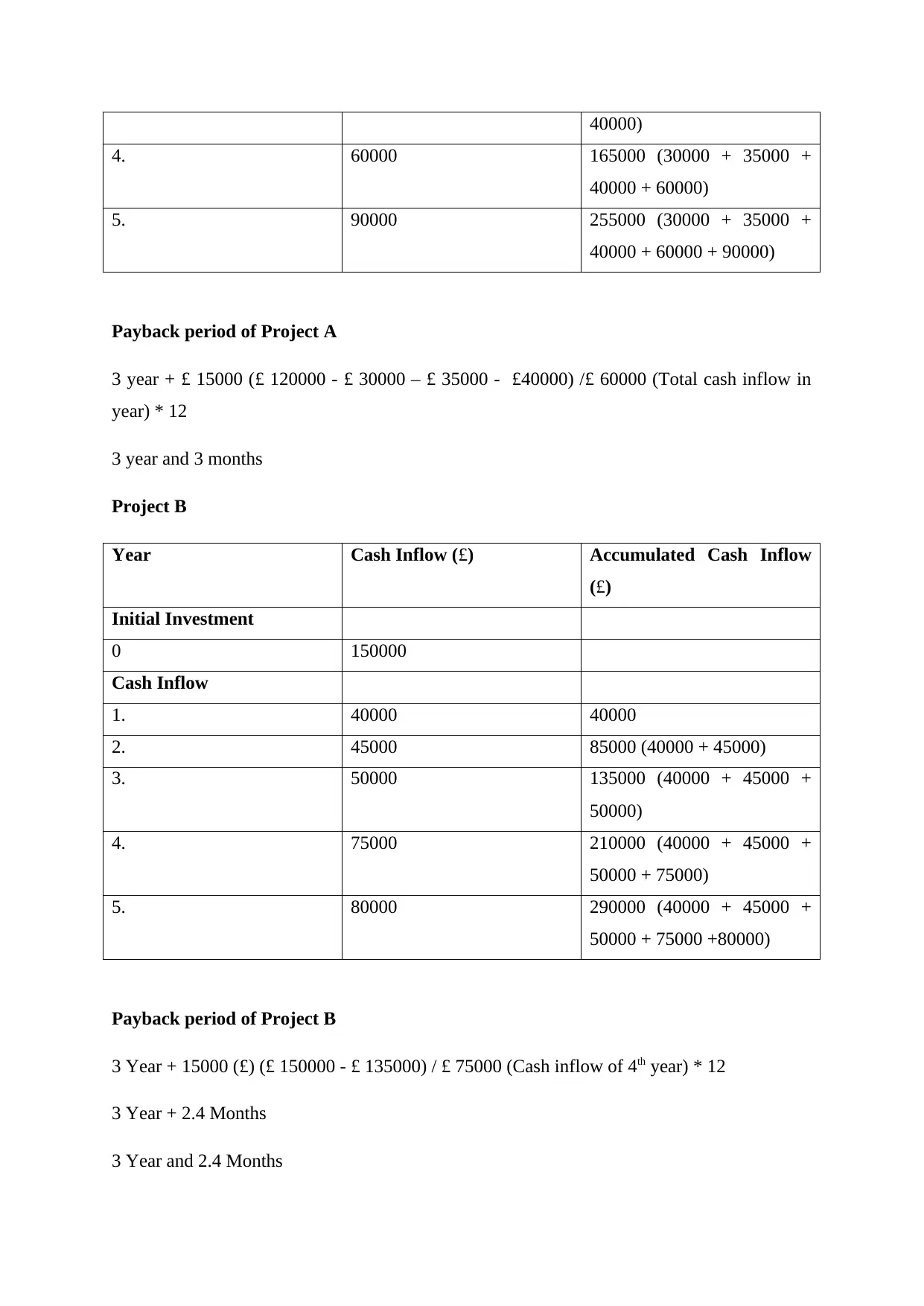
40000)
4. 60000 165000 (30000 + 35000 +
40000 + 60000)
5. 90000 255000 (30000 + 35000 +
40000 + 60000 + 90000)
Payback period of Project A
3 year + £ 15000 (£ 120000 - £ 30000 – £ 35000 - £40000) /£ 60000 (Total cash inflow in
year) * 12
3 year and 3 months
Project B
Year Cash Inflow (£) Accumulated Cash Inflow
(£)
Initial Investment
0 150000
Cash Inflow
1. 40000 40000
2. 45000 85000 (40000 + 45000)
3. 50000 135000 (40000 + 45000 +
50000)
4. 75000 210000 (40000 + 45000 +
50000 + 75000)
5. 80000 290000 (40000 + 45000 +
50000 + 75000 +80000)
Payback period of Project B
3 Year + 15000 (£) (£ 150000 - £ 135000) / £ 75000 (Cash inflow of 4th year) * 12
3 Year + 2.4 Months
3 Year and 2.4 Months
4. 60000 165000 (30000 + 35000 +
40000 + 60000)
5. 90000 255000 (30000 + 35000 +
40000 + 60000 + 90000)
Payback period of Project A
3 year + £ 15000 (£ 120000 - £ 30000 – £ 35000 - £40000) /£ 60000 (Total cash inflow in
year) * 12
3 year and 3 months
Project B
Year Cash Inflow (£) Accumulated Cash Inflow
(£)
Initial Investment
0 150000
Cash Inflow
1. 40000 40000
2. 45000 85000 (40000 + 45000)
3. 50000 135000 (40000 + 45000 +
50000)
4. 75000 210000 (40000 + 45000 +
50000 + 75000)
5. 80000 290000 (40000 + 45000 +
50000 + 75000 +80000)
Payback period of Project B
3 Year + 15000 (£) (£ 150000 - £ 135000) / £ 75000 (Cash inflow of 4th year) * 12
3 Year + 2.4 Months
3 Year and 2.4 Months
Paraphrase This Document
Need a fresh take? Get an instant paraphrase of this document with our AI Paraphraser
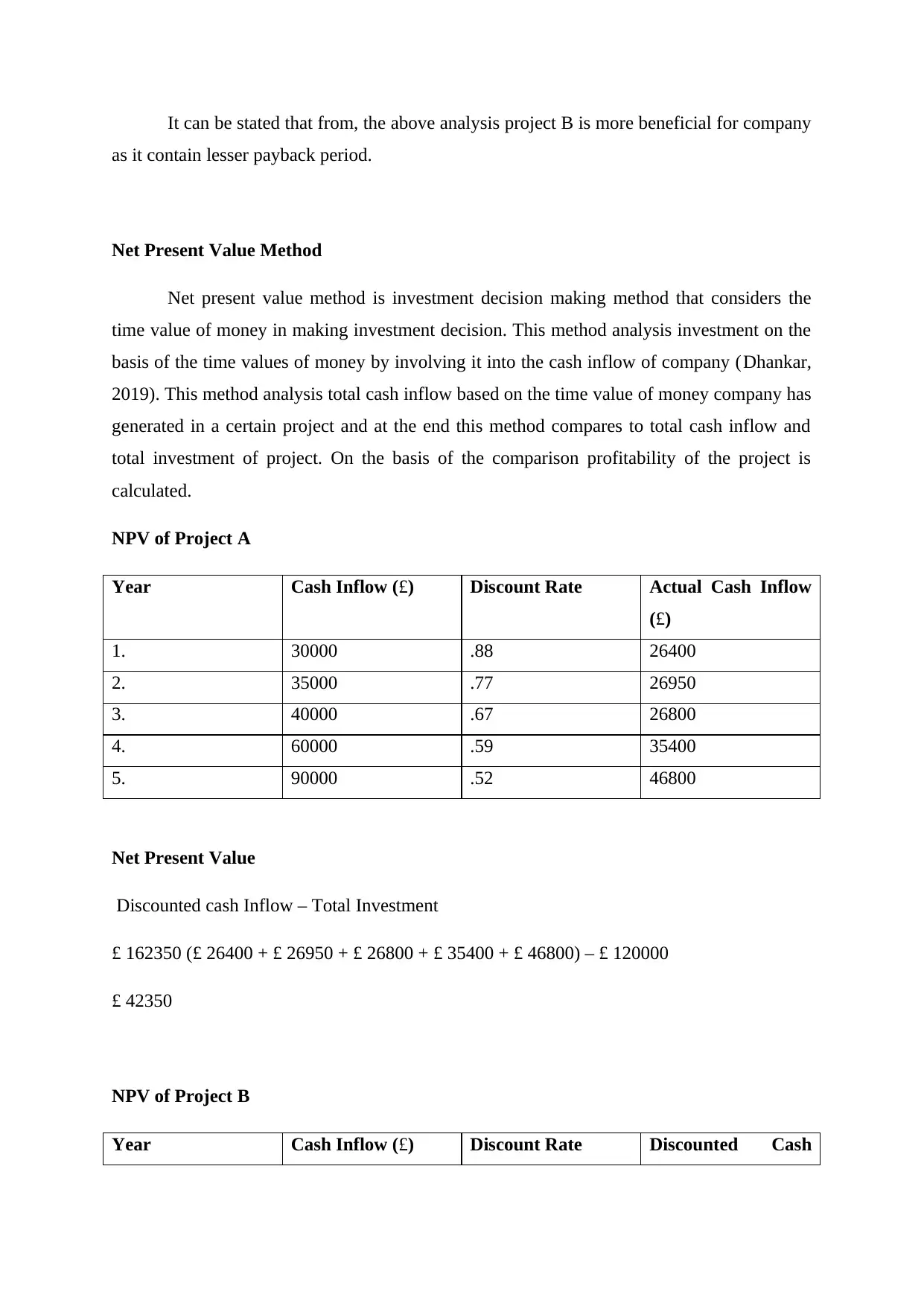
It can be stated that from, the above analysis project B is more beneficial for company
as it contain lesser payback period.
Net Present Value Method
Net present value method is investment decision making method that considers the
time value of money in making investment decision. This method analysis investment on the
basis of the time values of money by involving it into the cash inflow of company (Dhankar,
2019). This method analysis total cash inflow based on the time value of money company has
generated in a certain project and at the end this method compares to total cash inflow and
total investment of project. On the basis of the comparison profitability of the project is
calculated.
NPV of Project A
Year Cash Inflow (£) Discount Rate Actual Cash Inflow
(£)
1. 30000 .88 26400
2. 35000 .77 26950
3. 40000 .67 26800
4. 60000 .59 35400
5. 90000 .52 46800
Net Present Value
Discounted cash Inflow – Total Investment
£ 162350 (£ 26400 + £ 26950 + £ 26800 + £ 35400 + £ 46800) – £ 120000
£ 42350
NPV of Project B
Year Cash Inflow (£) Discount Rate Discounted Cash
as it contain lesser payback period.
Net Present Value Method
Net present value method is investment decision making method that considers the
time value of money in making investment decision. This method analysis investment on the
basis of the time values of money by involving it into the cash inflow of company (Dhankar,
2019). This method analysis total cash inflow based on the time value of money company has
generated in a certain project and at the end this method compares to total cash inflow and
total investment of project. On the basis of the comparison profitability of the project is
calculated.
NPV of Project A
Year Cash Inflow (£) Discount Rate Actual Cash Inflow
(£)
1. 30000 .88 26400
2. 35000 .77 26950
3. 40000 .67 26800
4. 60000 .59 35400
5. 90000 .52 46800
Net Present Value
Discounted cash Inflow – Total Investment
£ 162350 (£ 26400 + £ 26950 + £ 26800 + £ 35400 + £ 46800) – £ 120000
£ 42350
NPV of Project B
Year Cash Inflow (£) Discount Rate Discounted Cash
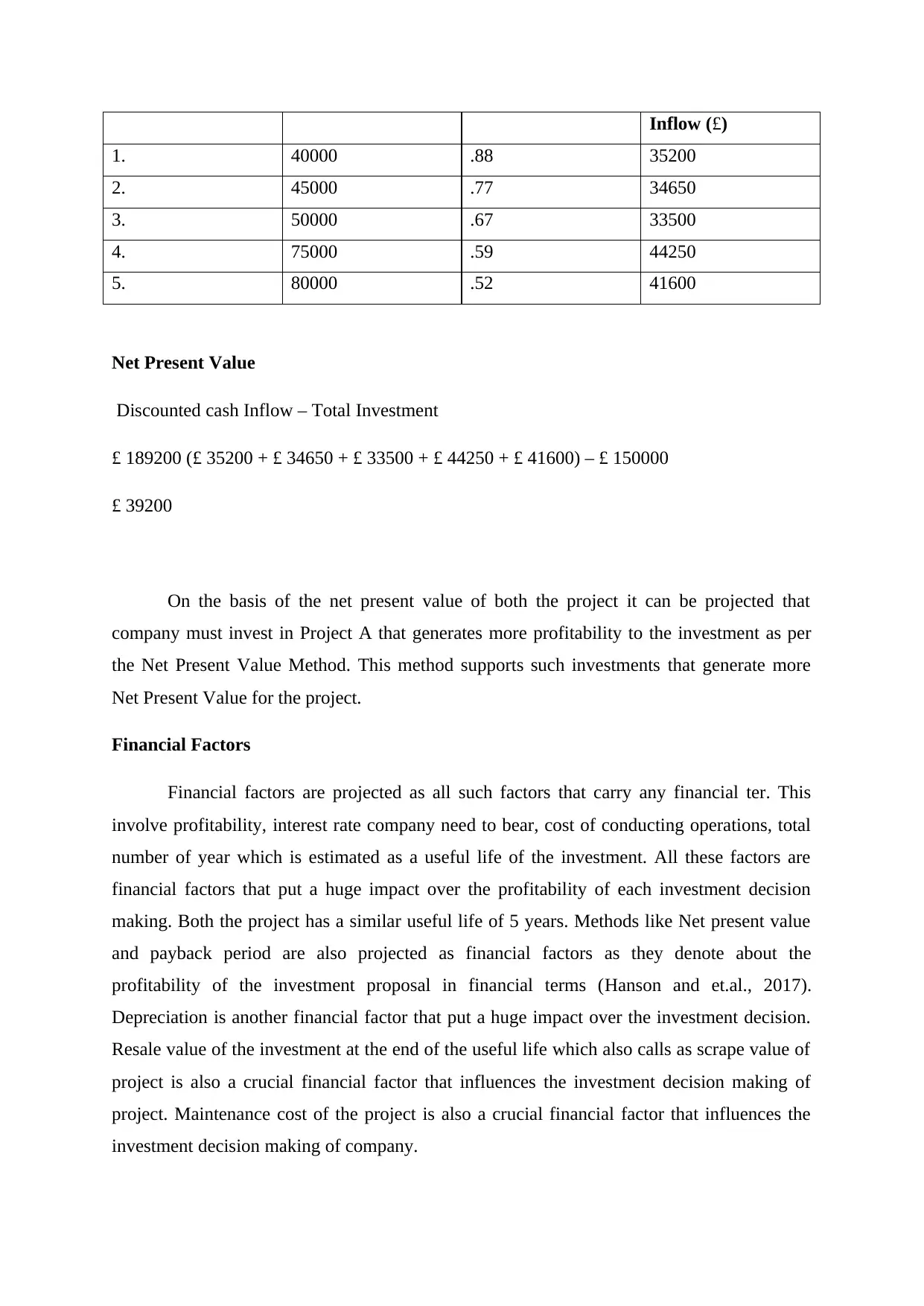
Inflow (£)
1. 40000 .88 35200
2. 45000 .77 34650
3. 50000 .67 33500
4. 75000 .59 44250
5. 80000 .52 41600
Net Present Value
Discounted cash Inflow – Total Investment
£ 189200 (£ 35200 + £ 34650 + £ 33500 + £ 44250 + £ 41600) – £ 150000
£ 39200
On the basis of the net present value of both the project it can be projected that
company must invest in Project A that generates more profitability to the investment as per
the Net Present Value Method. This method supports such investments that generate more
Net Present Value for the project.
Financial Factors
Financial factors are projected as all such factors that carry any financial ter. This
involve profitability, interest rate company need to bear, cost of conducting operations, total
number of year which is estimated as a useful life of the investment. All these factors are
financial factors that put a huge impact over the profitability of each investment decision
making. Both the project has a similar useful life of 5 years. Methods like Net present value
and payback period are also projected as financial factors as they denote about the
profitability of the investment proposal in financial terms (Hanson and et.al., 2017).
Depreciation is another financial factor that put a huge impact over the investment decision.
Resale value of the investment at the end of the useful life which also calls as scrape value of
project is also a crucial financial factor that influences the investment decision making of
project. Maintenance cost of the project is also a crucial financial factor that influences the
investment decision making of company.
1. 40000 .88 35200
2. 45000 .77 34650
3. 50000 .67 33500
4. 75000 .59 44250
5. 80000 .52 41600
Net Present Value
Discounted cash Inflow – Total Investment
£ 189200 (£ 35200 + £ 34650 + £ 33500 + £ 44250 + £ 41600) – £ 150000
£ 39200
On the basis of the net present value of both the project it can be projected that
company must invest in Project A that generates more profitability to the investment as per
the Net Present Value Method. This method supports such investments that generate more
Net Present Value for the project.
Financial Factors
Financial factors are projected as all such factors that carry any financial ter. This
involve profitability, interest rate company need to bear, cost of conducting operations, total
number of year which is estimated as a useful life of the investment. All these factors are
financial factors that put a huge impact over the profitability of each investment decision
making. Both the project has a similar useful life of 5 years. Methods like Net present value
and payback period are also projected as financial factors as they denote about the
profitability of the investment proposal in financial terms (Hanson and et.al., 2017).
Depreciation is another financial factor that put a huge impact over the investment decision.
Resale value of the investment at the end of the useful life which also calls as scrape value of
project is also a crucial financial factor that influences the investment decision making of
project. Maintenance cost of the project is also a crucial financial factor that influences the
investment decision making of company.
⊘ This is a preview!⊘
Do you want full access?
Subscribe today to unlock all pages.

Trusted by 1+ million students worldwide
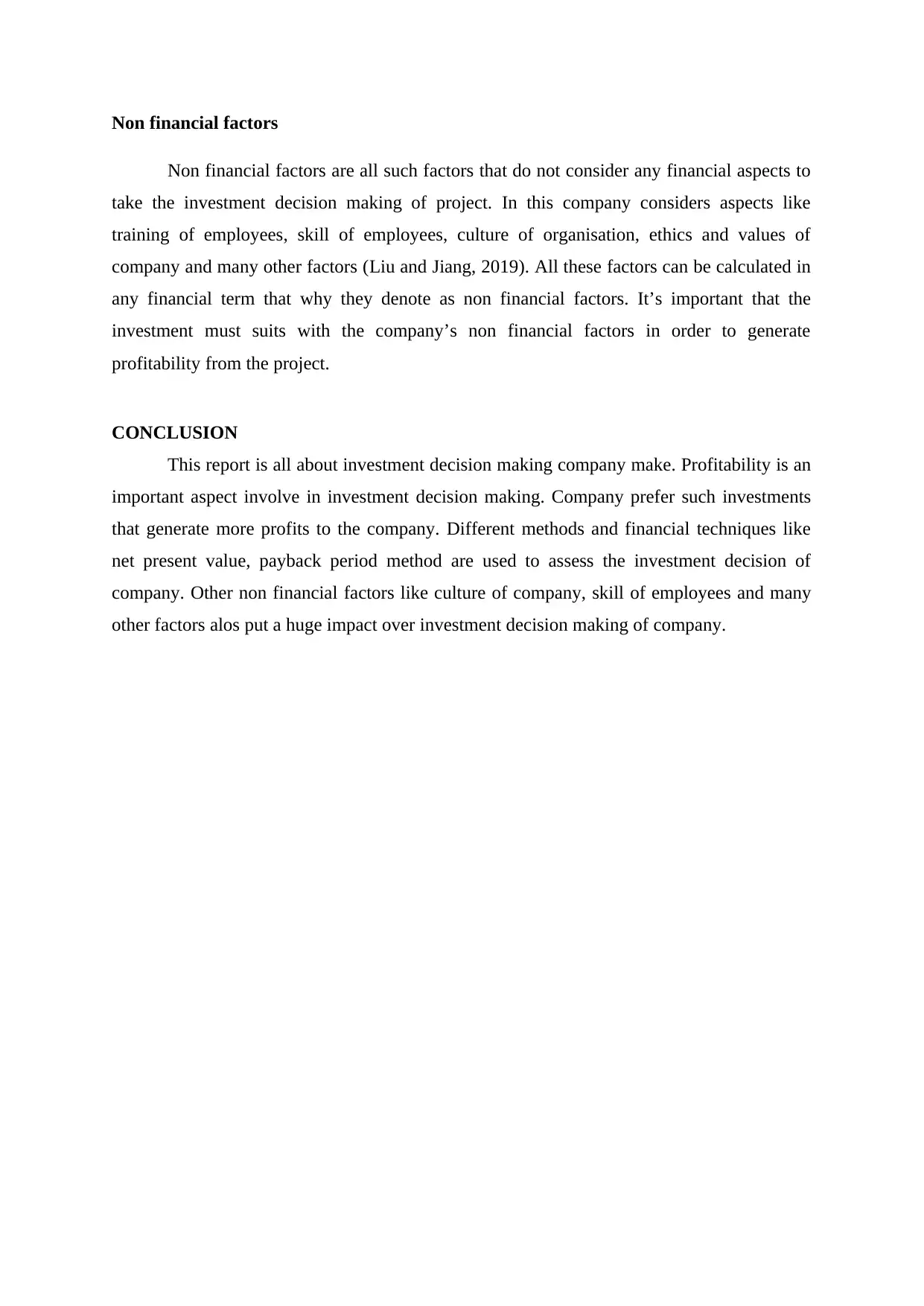
Non financial factors
Non financial factors are all such factors that do not consider any financial aspects to
take the investment decision making of project. In this company considers aspects like
training of employees, skill of employees, culture of organisation, ethics and values of
company and many other factors (Liu and Jiang, 2019). All these factors can be calculated in
any financial term that why they denote as non financial factors. It’s important that the
investment must suits with the company’s non financial factors in order to generate
profitability from the project.
CONCLUSION
This report is all about investment decision making company make. Profitability is an
important aspect involve in investment decision making. Company prefer such investments
that generate more profits to the company. Different methods and financial techniques like
net present value, payback period method are used to assess the investment decision of
company. Other non financial factors like culture of company, skill of employees and many
other factors alos put a huge impact over investment decision making of company.
Non financial factors are all such factors that do not consider any financial aspects to
take the investment decision making of project. In this company considers aspects like
training of employees, skill of employees, culture of organisation, ethics and values of
company and many other factors (Liu and Jiang, 2019). All these factors can be calculated in
any financial term that why they denote as non financial factors. It’s important that the
investment must suits with the company’s non financial factors in order to generate
profitability from the project.
CONCLUSION
This report is all about investment decision making company make. Profitability is an
important aspect involve in investment decision making. Company prefer such investments
that generate more profits to the company. Different methods and financial techniques like
net present value, payback period method are used to assess the investment decision of
company. Other non financial factors like culture of company, skill of employees and many
other factors alos put a huge impact over investment decision making of company.
Paraphrase This Document
Need a fresh take? Get an instant paraphrase of this document with our AI Paraphraser
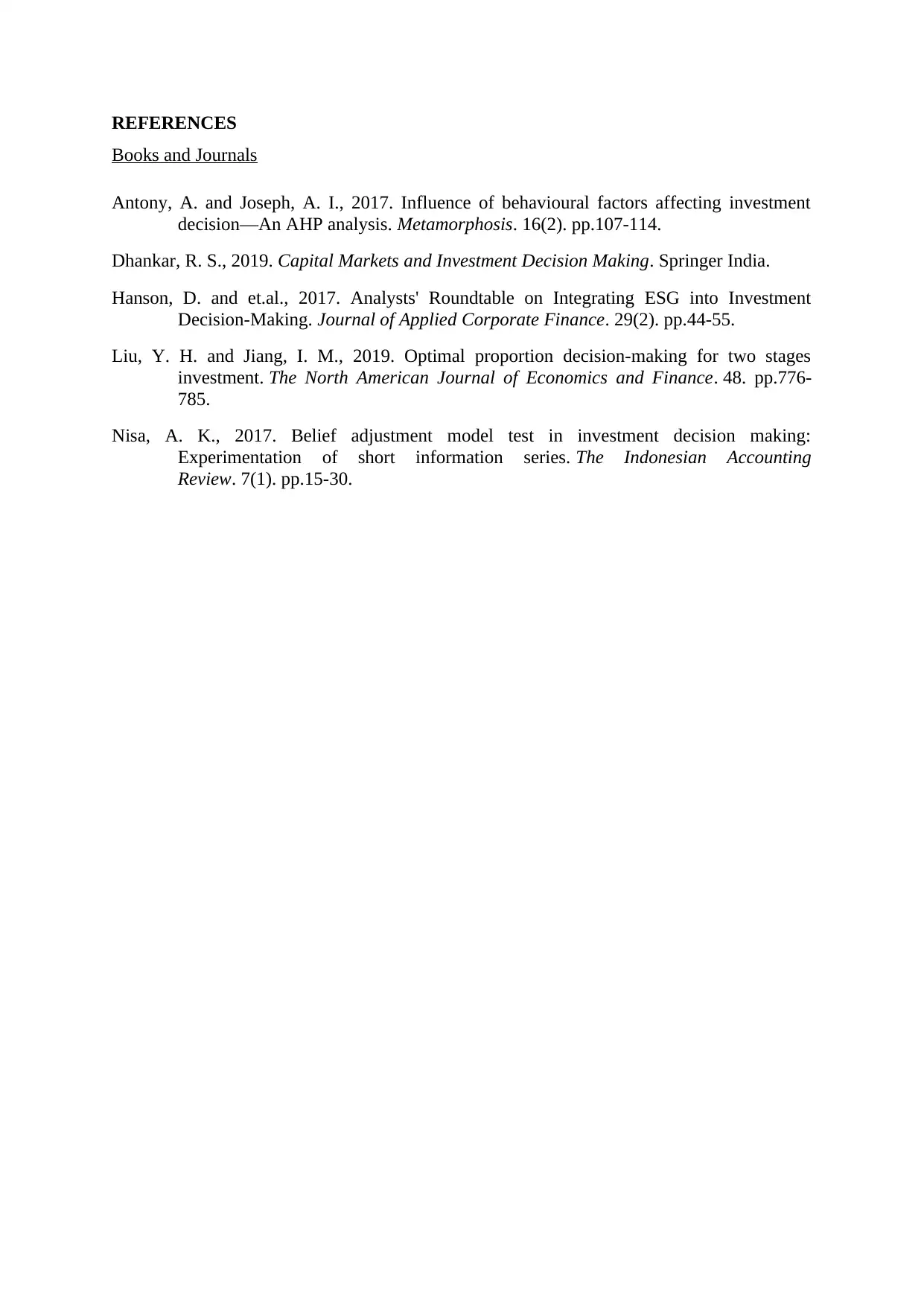
REFERENCES
Books and Journals
Antony, A. and Joseph, A. I., 2017. Influence of behavioural factors affecting investment
decision—An AHP analysis. Metamorphosis. 16(2). pp.107-114.
Dhankar, R. S., 2019. Capital Markets and Investment Decision Making. Springer India.
Hanson, D. and et.al., 2017. Analysts' Roundtable on Integrating ESG into Investment
Decision‐Making. Journal of Applied Corporate Finance. 29(2). pp.44-55.
Liu, Y. H. and Jiang, I. M., 2019. Optimal proportion decision-making for two stages
investment. The North American Journal of Economics and Finance. 48. pp.776-
785.
Nisa, A. K., 2017. Belief adjustment model test in investment decision making:
Experimentation of short information series. The Indonesian Accounting
Review. 7(1). pp.15-30.
Books and Journals
Antony, A. and Joseph, A. I., 2017. Influence of behavioural factors affecting investment
decision—An AHP analysis. Metamorphosis. 16(2). pp.107-114.
Dhankar, R. S., 2019. Capital Markets and Investment Decision Making. Springer India.
Hanson, D. and et.al., 2017. Analysts' Roundtable on Integrating ESG into Investment
Decision‐Making. Journal of Applied Corporate Finance. 29(2). pp.44-55.
Liu, Y. H. and Jiang, I. M., 2019. Optimal proportion decision-making for two stages
investment. The North American Journal of Economics and Finance. 48. pp.776-
785.
Nisa, A. K., 2017. Belief adjustment model test in investment decision making:
Experimentation of short information series. The Indonesian Accounting
Review. 7(1). pp.15-30.
1 out of 8
Related Documents
Your All-in-One AI-Powered Toolkit for Academic Success.
+13062052269
info@desklib.com
Available 24*7 on WhatsApp / Email
![[object Object]](/_next/static/media/star-bottom.7253800d.svg)
Unlock your academic potential
Copyright © 2020–2025 A2Z Services. All Rights Reserved. Developed and managed by ZUCOL.





